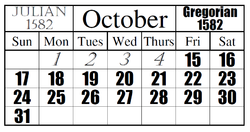| Years |
|---|
| Millennium |
| 2nd millennium |
| Centuries |
| Decades |
| Years |


1582 ( MDLXXXII ) was a common year starting on Monday in the Julian calendar, and a common year starting on Friday (link will display full calendar) of the Proleptic Gregorian calendar. This year saw the beginning of the Gregorian calendar switch, when the papal bull Inter gravissimas introduced the Gregorian calendar, adopted by Spain, Portugal, the Polish–Lithuanian Commonwealth and most of present-day Italy from the start. In these countries, the year continued as normal through Thursday, October 4; the next day became Friday, October 15, like a common year starting on Friday. France followed two months later, letting Sunday, December 9 be followed by Monday, December 20. Other countries continued using the Julian calendar, switching calendars in later years, and the complete conversion to the Gregorian calendar was not entirely done until 1923.






